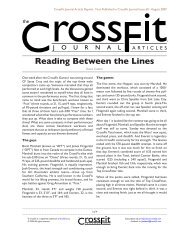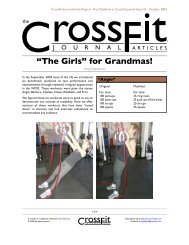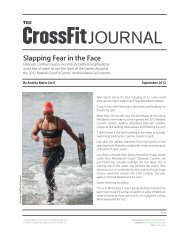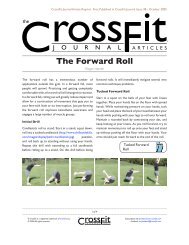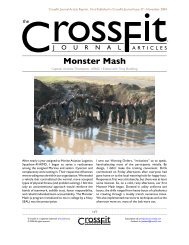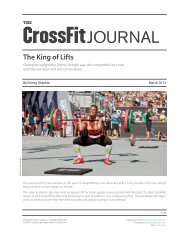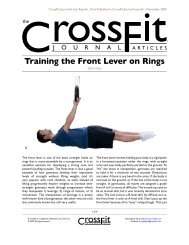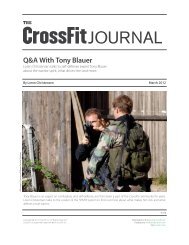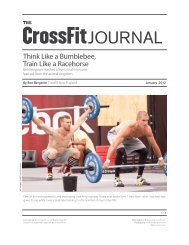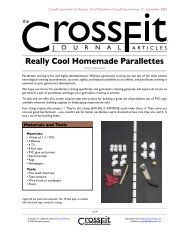JOURNAL - CrossFit
JOURNAL - CrossFit
JOURNAL - CrossFit
Create successful ePaper yourself
Turn your PDF publications into a flip-book with our unique Google optimized e-Paper software.
Jody Forster<br />
THE<br />
The Forgotten Lift<br />
Copyright © 2013 <strong>CrossFit</strong>, Inc. All Rights Reserved.<br />
<strong>CrossFit</strong> is a registered trademark ® of <strong>CrossFit</strong>, Inc.<br />
<strong>JOURNAL</strong><br />
Bill Starr explains the technique for the Olympic-style press, which helped set records<br />
but ultimately ushered the lift out of competition.<br />
By Bill Starr March 2013<br />
The overhead press was once the standard test of strength for anyone wanting to get considerably stronger. Whenever<br />
anyone wanted to know how strong you were, he always asked, “How much can you press?”<br />
The first goal that every beginner strived for was to clean and press his body weight. In some cases this took a year or<br />
more. The next goal was to be able to clean and press 200 lb. That separated the men from the boys. It still does in my<br />
opinion. How many athletes are able to handle that much weight currently? Very, very few. Of all the athletes that I have<br />
trained in various universities of the years, only a handful were able to handle 200 or more in the press.<br />
1 of 9<br />
Subscription info at http://journal.crossfit.com<br />
Feedback to feedback@crossfit.com<br />
Visit <strong>CrossFit</strong>.com
Forgotten ... (continued)<br />
How Much You Bench?<br />
Now, of course, the gauge of strength is the bench press,<br />
and 300 lb. is what 200 was for the overhead press. If the<br />
overhead press is even part of the strength program, it is<br />
almost always relegated to being an auxiliary exercise, and<br />
only moderate to light weights are used. Why did this switch<br />
from the overhead press to the flat bench come about?<br />
The first reason was an innovation that Tony Garcy of the<br />
York Barbell Club came up with in the early ’60s. He invented<br />
a highly technical style of pressing that required timing,<br />
quickness, coordination and—most of all—balance.<br />
Previously, Olympic lifters used brute strength to elevate<br />
their presses. Tony’s version was a high-skill movement,<br />
and it took a great deal of practice before anyone could<br />
get the feel of what he was trying to do.<br />
Tony Garcy invented a highly<br />
technical style of pressing that<br />
required timing, quickness,<br />
coordination and—most of<br />
all—balance.<br />
When the foreign lifters saw him press in the ’64 Olympics<br />
and ’65 Worlds, they saw that he was onto something<br />
and began copying his style. Within a short time, nearly<br />
every foreign Olympic lifter was using the technique with<br />
great success, and it was referred to as the “Olympic style”<br />
or “European style” press. Few people know that it was<br />
Tony and not any foreign country that developed this<br />
dynamic lift.<br />
While the newer style sent records soaring in all weight<br />
classes, it became the death knell for the press because<br />
it became extremely hard to judge. The bar was rarely<br />
pressed at all. It shot off the shoulders and was instantly<br />
locked out. And those who leaned back excessively made<br />
the move in the blinking of an eye, so it was difficult to tell<br />
if the lifter leaned back too far, which was the reason for<br />
disqualification. But the hardest part to judge was determining<br />
if the lifter started the lift with bent knees.<br />
Copyright © 2013 <strong>CrossFit</strong>, Inc. All Rights Reserved.<br />
<strong>CrossFit</strong> is a registered trademark ® of <strong>CrossFit</strong>, Inc.<br />
The Olympic press employs a degree of layback, and<br />
athletes need to train to be able to use the technique<br />
without injury. It takes years of practice to develop the<br />
strength required for safe layback with heavy loads.<br />
2 of 9<br />
Subscription info at http://journal.crossfit.com<br />
Feedback to feedback@crossfit.com<br />
Visit <strong>CrossFit</strong>.com<br />
Staff/<strong>CrossFit</strong> Journal<br />
Staff/<strong>CrossFit</strong> Journal
Staff/<strong>CrossFit</strong> Journal<br />
Forgotten ... (continued)<br />
Judging became erratic, especially so on the international<br />
stage, where politics came into play. Some lifters<br />
were able to get away with such blatant knee kicks that<br />
the lift looked like a push press. The battles between the<br />
Communist countries and those favoring democracy were<br />
the ones where the judges used the press to keep lifters<br />
from doing well. At the ’68 Olympics , I watched a Cuban<br />
lifter elevate his first two attempts in the press in a strong,<br />
steady fashion. Two judges, one from Puerto Rico and the<br />
other from Canada, gave him red lights. They did give him<br />
white lights on his final attempt, but they had made sure<br />
that he would not be in contention for a medal.<br />
It became obvious that the International Olympic<br />
Committee had lost all control over the judges when it<br />
came to the press. But how could they eliminate a lift that<br />
had been an integral part of the sport for so many years?<br />
Initially, they tested the waters with the idea that dropping<br />
the press would make the meets much shorter. That didn’t<br />
wash because long meets only occurred at a few contests,<br />
mostly on the East Coast.<br />
Cleaning and pressing 200 lb. or more is<br />
an impressive feat of strength few can perform.<br />
Copyright © 2013 <strong>CrossFit</strong>, Inc. All Rights Reserved.<br />
<strong>CrossFit</strong> is a registered trademark ® of <strong>CrossFit</strong>, Inc.<br />
That’s when someone came up with the idea of safety.<br />
All of a sudden, there were articles on the subject that<br />
overhead pressing was harmful to the lower back due to<br />
leaning backward to finish the lift. Athletic trainers, sportsmedicine<br />
doctors and coaches, mostly those who thought<br />
all weight training was dangerous, joined the bandwagon.<br />
In 1972, the International Olympic Weightlifting Committee<br />
voted to eliminate the press from official competition. For<br />
the record, there was never any evidence to show that the<br />
lift was harmful to the back. In fact, overhead pressing is<br />
one of the very best exercises to strengthen certain parts<br />
of the back, which I’ll get into later on.<br />
In this same time frame, several other events happened<br />
that altered the status of the overhead press from a<br />
primary movement to an ancillary exercise. Joe Weider<br />
took control of the sport of bodybuilding and immediately<br />
dropped the athletic points that were part of the AAU<br />
rules. A bodybuilder could gain those five points by participating<br />
in any sport, and because most were doing many of<br />
the same exercises as the Olympic lifters in the gym, they<br />
entered Olympic meets.<br />
The lift that the majority of bodybuilders excelled at was<br />
the press because they did lots of them. They believed,<br />
and rightly so, that the overhead press was one of the very<br />
best exercises to build a strong, impressive upper body.<br />
There are few exercises that can develop the deltoids and<br />
triceps as well as overhead presses.<br />
No longer was the press a<br />
test of upper-body strength.<br />
But it should be.<br />
Yet once the athletic points were dropped, aspiring physique<br />
contestants stopped doing the three Olympic lifts and the<br />
flat bench replaced the overhead press in their routines. I<br />
have to believe most of them did this simply because the<br />
flat bench is much easier to do than the overhead press.<br />
While this was going on, the sport of powerlifting was<br />
growing rapidly. It was much easier to train on the static lifts<br />
3 of 9<br />
Subscription info at http://journal.crossfit.com<br />
Feedback to feedback@crossfit.com<br />
Visit <strong>CrossFit</strong>.com
Staff/<strong>CrossFit</strong> Journal<br />
Forgotten ... (continued)<br />
In the start position, your wrists should be as straight as possible, and you can use tape to enforce the position if flexibility is lacking.<br />
than it was the more complicated Olympic movements.<br />
The bench press was the test of strength for the upper<br />
body in powerlifting, and for the most part, the overhead<br />
press was completely ignored.<br />
Strength training for athletes was also emerging during<br />
this time, and Tommy Suggs and I did everything we could<br />
to push this movement forward. With the full backing of<br />
Bob Hoffman, owner of the York Barbell Company, we put<br />
on countless exhibitions and clinics and attended several<br />
coaching conventions every winter. That’s when we came<br />
up with the Big Three, a simplified strength program that<br />
could be done with a minimum of equipment. It consisted<br />
of the power clean, back squat and bench press (see The<br />
Holy Trinity of Strength Training, published May 27, 2009).<br />
Although we both believed the overhead press to be<br />
the better lift to develop upper-body strength, we didn’t<br />
want to have to defend two of the three exercises in the<br />
program. We had our hands full with the back squat,<br />
primarily because of the bogus research done by Dr. K.K.<br />
Klein at the University of Texas. Our second choice after<br />
the overhead press was the incline benches found in<br />
some high schools and colleges. In truth, not many fitness<br />
centers or gyms even had them.<br />
Copyright © 2013 <strong>CrossFit</strong>, Inc. All Rights Reserved.<br />
<strong>CrossFit</strong> is a registered trademark ® of <strong>CrossFit</strong>, Inc.<br />
So by default, the bench press became part of the Big<br />
Three, and after I published The Strongest Shall Survive, it<br />
became a fixture in every strength program in the country.<br />
And finally, highly engineered exercise machines, such as<br />
the Nautilus, exploded on the scene. As a result of all these<br />
changes, the overhead press virtually disappeared from<br />
the scene, and if it was included in a program, it was always<br />
done with light weight, usually at the end of the workout.<br />
No longer was it a test of upper-body strength.<br />
But it should be.<br />
Safe and Effective<br />
As far as the safety factor, the overhead press is not nearly as<br />
harmful as the flat bench. In the quest for higher and higher<br />
numbers in the bench press, athletes resort to rebounding<br />
the bar off the chests and bridging when the bar sticks on<br />
its way up. Both are extremely stressful to the shoulders and<br />
elbows and, in some cases, the wrists as well.<br />
The accusation that leaning back excessively in the press<br />
put the lower back in jeopardy was partially true. But what<br />
was understood was that those who did lean way back<br />
only did this after years of practice. And over those years,<br />
the muscles and attachments in the lower back grew<br />
4 of 9<br />
Subscription info at http://journal.crossfit.com<br />
Feedback to feedback@crossfit.com<br />
Visit <strong>CrossFit</strong>.com
Forgotten ... (continued)<br />
stronger and stronger so they were able to handle the<br />
stress. Secondly, as every athlete learns quickly, it’s not easy<br />
to lay back when pressing a heavy weight.<br />
What was understood<br />
was that those who did<br />
lean way back only did this<br />
after years of practice.<br />
Some layback is desirable and necessary in order to handle<br />
a max attempt. But to lay back at the exact moment to help<br />
the bar stay in motion is a difficult skill to master. Timing<br />
and balance are critical, and it takes a whole lot of practice<br />
to get it down pat. This aspect of the lift was the most<br />
difficult to learn for all the athletes I taught to press in this<br />
fashion. So laying back too much is not really a problem at<br />
all, which means the lower back is not in danger of being<br />
overly stressed. As I just mentioned, as the athlete perfects<br />
this move over time, he is also making his lumbars, and the<br />
other muscles in his back, stronger.<br />
Another point in favor of overhead presses is that they<br />
strengthen the rotator cuffs. When the press was still the<br />
standard of strength, no one had ever heard of an injury to<br />
the rotator cuff. In fact, they were unknown muscles. If you<br />
asked the most knowledgeable coach or lifter where they<br />
were located, they wouldn’t have the faintest idea. They’re<br />
not even mentioned in the kinesiology and applied<br />
anatomy text that was considered the best on the subject<br />
in the ’60s.<br />
The current rash of rotator-cuff problems can be directly<br />
linked to overworking the bench press and the lack of<br />
overhead exercises. When a weight is pressed overhead,<br />
those rotator cuffs are strengthened considerably. When<br />
doing a flat bench, they are not. Whenever athletes come<br />
to me seeking advice about their rotator cuffs and are not<br />
yet to the point where medical attention is required, I start<br />
them on overhead presses. I have them use dumbbells for<br />
several weeks before graduating to a bar. I also have them<br />
drop the flat benches completely and do overhead presses<br />
three times a week. It works, although it may take several<br />
Copyright © 2013 <strong>CrossFit</strong>, Inc. All Rights Reserved.<br />
<strong>CrossFit</strong> is a registered trademark ® of <strong>CrossFit</strong>, Inc.<br />
months for them to get their rotator cuffs strong enough<br />
so that they stop hurting. The overhead press is a perfectly<br />
safe and very beneficial exercise when it is done correctly.<br />
But this is true for every exercise in strength training,<br />
including rather tame movements such as curls, lateral<br />
raises, bent-over rows and even back hyperextensions.<br />
One of the things I liked about doing overhead presses<br />
from the very beginning was they could be done with a<br />
minimum of equipment. All I had at my disposal for the<br />
first two-and-a-half years I trained were standard bars<br />
and weights. They worked just fine. I think having to turn<br />
the bar over during the clean rather than having the bar<br />
revolve smoothly actually helped me get a bit stronger.<br />
I also like the idea that I could do the movement alone,<br />
because I was the only person using the base gyms during<br />
my service. No spotter was necessary, and if I failed with<br />
an attempt, I simply let the bar come back down to my<br />
shoulders and put it on down to the floor.<br />
Cleaning and pressing weights helped me build a stronger<br />
foundation than pressing off a rack. I did the combination<br />
movement for the simple reason that there were no racks<br />
available. And this was the same for nearly every other<br />
strength athlete in the ’50s. We made use of what we had<br />
available, and it forced us to work harder than those who<br />
followed us and had the luxury of equipment that made<br />
things easier.<br />
The Press: A Quick Lift<br />
Having made my case for the merits of overhead presses, I’ll<br />
move on to how to perform them correctly. Even if you do<br />
not plan on adding presses to your routine permanently, it’s<br />
still a smart idea to understand the various form points in<br />
the event you want to teach the lift to someone else.<br />
While learning how to do this dynamic style of the press, I<br />
find it’s best to take the bar off the rack rather than cleaning<br />
it. That is, of course, if you have a rack in your weight room.<br />
This will allow you to concentrate on the various parts<br />
of the lift without having to think about the clean. Begin<br />
with an empty Olympic bar. Your grip for the press is about<br />
the same as you would use for power cleans or deadlifts.<br />
Extended your thumbs on an Olympic bar so that they<br />
just touch the smooth center. Should you have very wide<br />
shoulders, a wider grip will be needed, and vice versa for<br />
those with narrow shoulders. The general rule of thumb for<br />
all pressing movements is that your forearms are vertical<br />
during the exercise.<br />
5 of 9<br />
Subscription info at http://journal.crossfit.com<br />
Feedback to feedback@crossfit.com<br />
Visit <strong>CrossFit</strong>.com
Staff/<strong>CrossFit</strong> Journal<br />
Forgotten ... (continued)<br />
The rack position is extremely important, and it’s slightly<br />
different than the rack for a jerk. The bar should rest on your<br />
frontal deltoids without touching your collarbones, at that<br />
point where the sternum meets the clavicles. To provide a<br />
muscular ledge on which to place the bar, just shrug your<br />
entire shoulder girdle upward so that your frontal deltoids<br />
provide that ledge.<br />
Your elbows will be down and tucked in tightly against<br />
your lats. Your wrists have to be absolutely straight. Should<br />
you have trouble keeping your wrists locked at any stage<br />
of the lift, wrap them with trainer’s tape. This is a good<br />
idea for anyone just learning the lift because the wrists<br />
are placed under a new form of stress, and an ounce of<br />
prevention is still worth a pound of cure. Never allow your<br />
wrists to flex during the execution of the press because<br />
that diminishes the power generated from the shoulders<br />
into your arms and finally the bar.<br />
Pressing really starts with your feet, so your base has to be<br />
solid and in the right position. Set your feet at shoulder<br />
width with your toes pointed straight ahead. Your feet<br />
need to be in this position so that the weight can be<br />
Copyright © 2013 <strong>CrossFit</strong>, Inc. All Rights Reserved.<br />
<strong>CrossFit</strong> is a registered trademark ® of <strong>CrossFit</strong>, Inc.<br />
shifted from the balls of your feet to your heels, then back<br />
again to the balls in a nanosecond.<br />
To ensure a strong base, think about gripping the floor<br />
with your toes, much like a bird locked firmly to a tree limb.<br />
Everything up to this point is the same as if you were about<br />
to do a conventional overhead press, but now the form<br />
becomes quite different. With your knees straight, extend<br />
your pelvis forward and create a bow with your body. The<br />
bow starts at the back of your heels and ends at the back<br />
of your head. The bar should be directly over the center of<br />
your feet and your hips so you will be starting the lift from<br />
your power base.<br />
Take a moment to tighten every muscle in your body, with<br />
special attention to your abs and glutes. Imagine yourself<br />
as a powerful coil of steel. I said that your knees needed<br />
to be straight, but they shouldn’t be locked. This is usually<br />
confusing to a lifter. Yes, this is how they teach recruits to<br />
stand at parades in the military. Those who didn’t heed<br />
the instructions often fainted because the locked-out<br />
legs impeded circulation. Try it without the bar and you’ll<br />
understand what I mean.<br />
By locking your knees aggressively (Frame 2), the bar will jump upward. Then you must quickly drop back into your starting<br />
position while continuing to push the bar upward (Frame 3). This technique requires a precise bar path and perfect timing.<br />
6 of 9<br />
Subscription info at http://journal.crossfit.com<br />
Feedback to feedback@crossfit.com<br />
Visit <strong>CrossFit</strong>.com
Staff/<strong>CrossFit</strong> Journal<br />
Forgotten ... (continued)<br />
It can take years to develop any proficiency in the Olympic press, which became popular in the ‘60s.<br />
Get set in that coil, then blast the bar upward in a very<br />
precise line, and at that same moment, lock your knees.<br />
That combination will send the bar flying upward. Here’s<br />
the tricky part: as soon as you have uncoiled and locked<br />
your knees, you must drop back into that coiled starting<br />
position while continuing to put pressure on the moving<br />
bar. Lock it out and hold it for a few seconds overhead.<br />
The bar should be set on a line right above the back of<br />
your head. Then lower it back to your shoulders and take a<br />
few moments to make sure all your mechanics are correct<br />
before doing the next rep.<br />
This Olympic-style press is<br />
really a quick lift and is more<br />
difficult to learn than either<br />
the squat snatch or squat clean.<br />
Copyright © 2013 <strong>CrossFit</strong>, Inc. All Rights Reserved.<br />
<strong>CrossFit</strong> is a registered trademark ® of <strong>CrossFit</strong>, Inc.<br />
This Olympic-style press is really a quick lift and is more<br />
difficult to learn than either the squat snatch or squat clean.<br />
So don’t expect to do it perfectly right away. It takes tons of<br />
reps before you will finally get the feel of what you’re trying<br />
to do. But those who have the determination and patience<br />
to drill on this high-skill movement all eventually come to<br />
me and say, “One day, it just happened. The bar shot off<br />
my shoulders and was suddenly locked out overhead. It<br />
was like magic.” When done absolutely correctly, that’s just<br />
what the lift feels like.<br />
A few more points:<br />
• Never follow the upward-moving bar with your eyes.<br />
This will make you lean too far backward in the middle<br />
and final stages of the lift. In Frame 3 on Page 6, the<br />
lifter should be looking straight ahead rather than at<br />
the bar.<br />
• As you are coiled and about to launch the bar upward,<br />
your weight needs to be pushed forward, over your<br />
toes. When you drive the bar off your shoulders and<br />
come erect, the weight shifts to your heels, and when<br />
you drop back into the starting position, the weight<br />
shifts once again back to your toes.<br />
7 of 9<br />
Subscription info at http://journal.crossfit.com<br />
Feedback to feedback@crossfit.com<br />
Visit <strong>CrossFit</strong>.com
Staff/<strong>CrossFit</strong> Journal<br />
Forgotten ... (continued)<br />
• At the conclusion of the start, your body must be<br />
completely erect so that you can put all your power<br />
into the bar. Over time, you will also be able to include<br />
your traps into that initial move, which will add even<br />
more punch.<br />
• Also, as you drop back into the coiled position, you<br />
absolutely must maintain control of the line of<br />
flight of the bar and keep pushing up against it. Any<br />
hesitation in that move and the bar will stall. With max<br />
poundage, that will result in a failure.<br />
Driving the bar upward with a burst of power in a very<br />
precise line is one of the hardest parts of this form of<br />
pressing. It requires a great deal of practice, and for those<br />
who have difficulty with this part of the lift, I have them drill<br />
on the start until their line is tight on every rep. Then they<br />
can incorporate the middle and finish into the movement<br />
more readily.<br />
The key to making an Olympic press with a considerable<br />
amount of weight is locking your knees during the start<br />
with authority. This is exactly what ski jumpers do. When<br />
they hit the end of their takeoff, they snap their knees into<br />
a locked position, and this provides them with that extra<br />
bit of power to soar higher. The same idea applies to the<br />
Olympic press. By locking your knees forcefully, that added<br />
pop sends the bar a fraction higher, which gives you the<br />
time to recoil and press the bar to lockout.<br />
The knees are locked out in Frame 1—an error in start<br />
position. They are straight but unlocked in Frame 2,<br />
allowing the lifter to snap them into a locked position.<br />
Copyright © 2013 <strong>CrossFit</strong>, Inc. All Rights Reserved.<br />
<strong>CrossFit</strong> is a registered trademark ® of <strong>CrossFit</strong>, Inc.<br />
When every move is in sync, the bar will blast off your<br />
shoulders and be locked out in the blinking of an eye, and<br />
you will understand why it was so difficult for the judges<br />
to see any infractions. It’s important to remember that<br />
you really don’t lean back. You will be pushing your pelvis<br />
forward until you’re curled into a tight, powerful coil.<br />
It’s important to remember<br />
that you really don’t lean back.<br />
You will be pushing your pelvis<br />
forward until you’re curled<br />
into a tight, powerful coil.<br />
While learning this athletic movement, you might want<br />
to just do 3 reps per set so that you can fully focus on<br />
the various form points. But once you feel confident that<br />
you’re doing the lift correctly, start following this routine:<br />
3 sets of 5 as warm-ups, then 3 sets of triples. After a few<br />
weeks, add in another set of triples, then do it again after<br />
another month, so that you’re getting in a total of 8 sets.<br />
And every so often, do doubles or singles instead of triples.<br />
Those who have done conventional presses in the past or<br />
are still doing them will have more difficulty with the form<br />
on the Olympic press than those who have never done any<br />
type of pressing. But with practice, those with experience<br />
can make the switch. That’s what nearly every lifter in the<br />
’60s had to do in order to be competitive. It took me the<br />
better part of a year to make the adjustment, and I still wasn’t<br />
as proficient as some of the younger lifters who learned the<br />
Olympic-style press at the very beginning of their careers.<br />
The question naturally comes up, “Why not just do a<br />
conventional press instead of having to spend a great deal<br />
of time with the more complicated Olympic press?”<br />
If a person is just interested in bodybuilding, the conventional<br />
press is fine. But if an athlete would like to include<br />
an exercise in his strength program that not only will make<br />
him considerably stronger but will also enhance a host of<br />
athletic attributes—such as timing, coordination and most<br />
of all balance—then he should learn to do the Olympicstyle<br />
press.<br />
8 of 9<br />
Subscription info at http://journal.crossfit.com<br />
Feedback to feedback@crossfit.com<br />
Visit <strong>CrossFit</strong>.com
Staff/<strong>CrossFit</strong> Journal<br />
Forgotten ... (continued)<br />
Strive to keep your wrists absolutely straight<br />
in the set-up for the press.<br />
When high-skill exercises such as full cleans, snatches,<br />
jerks and Olympic presses are done to perfection in the<br />
weight room, the attributes that are greatly enhanced by<br />
the dynamic lifts can be carried into any sports venue. In<br />
other words, lifts that require you to utilize a great many<br />
attributes will make you a better athlete.<br />
Besides, you will discover that doing Olympic presses is<br />
fun, and you can’t say that for many exercises in strength<br />
training.<br />
Then when someone asks you “How much can you bench?”<br />
you can reply, “I don’t do benches, but I can overhead press<br />
200 lb. Can you?”<br />
F<br />
Copyright © 2013 <strong>CrossFit</strong>, Inc. All Rights Reserved.<br />
<strong>CrossFit</strong> is a registered trademark ® of <strong>CrossFit</strong>, Inc.<br />
About the Author<br />
Bill Starr coached at the 1968 Olympics in Mexico City, the 1970<br />
Olympic Weightlifting World Championship in Columbus,<br />
Ohio, and the 1975 World Powerlifting Championships in<br />
Birmingham, England. He was selected as head coach of the<br />
1969 team that competed in the Tournament of Americas in<br />
Mayaguez, Puerto Rico, where the United States won the team<br />
title, making him the first active lifter to be head coach of an<br />
international Olympic weightlifting team. Starr is the author<br />
of the books The Strongest Shall Survive: Strength Training<br />
for Football and Defying Gravity, which can be found at The<br />
Aasgaard Company Bookstore.<br />
9 of 9<br />
Subscription info at http://journal.crossfit.com<br />
Feedback to feedback@crossfit.com<br />
Visit <strong>CrossFit</strong>.com



